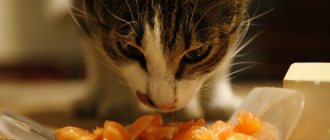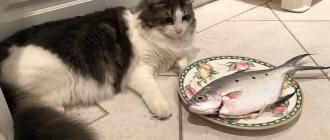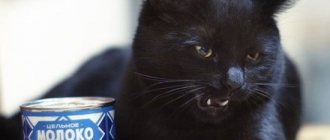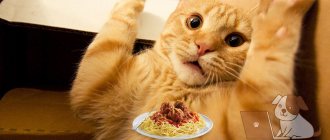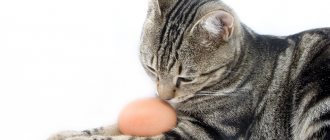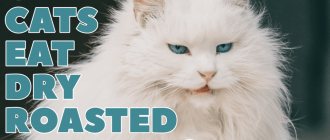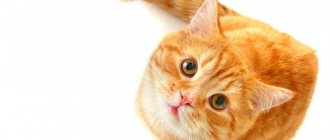7705Pavel
1
The beneficial effects of good nutrition on the health and activity of a domestic cat have been proven one hundred percent. To ensure that your pet not only feels good, but also behaves actively, you should feed it natural products, a mix of fresh vegetables and cereals. Taking this into account, the answer to the question whether cats can eat buckwheat will definitely be positive. Cereal crops are especially beneficial for animals - rolled oats, buckwheat, rice and oatmeal. They have a good effect on the cat's digestion.
What cereals can be given to cats?
Not all types of cereals are approved for consumption by cats, so before creating a diet, you need to figure out which cereals can be given to cats and which cannot? Among those useful for the cat's body are oatmeal, rice, buckwheat and barley groats.
Not all cereals can be given to cats
Cats are very capricious animals and it will be quite difficult to force them to eat porridge, so you still need to figure out how to lure the animal to such an unusual dish for them.
Buckwheat
The owner, before creating a diet for his pet, wonders whether a cat can eat buckwheat at all and will he eat it? It contains many components necessary for the body: proteins, carbohydrates, fiber, which can be converted into energy, as well as iron and calcium. Buckwheat porridge is especially important for a cat, because it contributes to its full development.
Must remember! For a kitten, porridge is prepared with milk with the addition of a small piece of butter, and for an adult animal - with broth.
Rice
Is it possible to give buckwheat to kittens and cats have figured it out, but what about rice cereal? The question is very serious, because it takes a lot of time to digest rice, but its benefits for the animal’s body are very great. Cereals contain many useful substances, but experts recommend introducing unpolished rice into the diet; it is more beneficial than regular rice.
Rice porridge must be prepared in vegetable broth, and when feeding an animal, mixed with meat or vegetables.
Rice porridge is very healthy for cats
Oatmeal
Oatmeal must be included in the diet. It is well absorbed by the body and cleanses the intestines. In addition, rolled oats are useful for both small kittens and adults. It contains many vitamins and mineral salts.
Some owners prefer to mix oatmeal with ready-made liquid food, but this should not be done. It is better to combine it with pieces of boiled meat, such as chicken, or with vegetables.
Advice! It is recommended to cook porridge for kittens in milk or steam it.
Barley porridge
This category includes pearl barley porridge and egg, which contain the most vitamins D, E, A, B and PP, as well as such important elements as iron, selenium, potassium, strontium, copper and manganese. Cats should be given barley and barley no more than 2 times a week and only if there is no gluten intolerance. Barley porridge is important for kittens for bone growth, and for adults it is necessary for the proper functioning of the digestive tract.
Useful material
Buckwheat is a dietary product that can be given to people and animals. The cereal contains:
- fiber;
- iron;
- zinc;
- cobalt;
- phosphorus;
- iodine;
- copper;
- vitamin E and PP, group B compounds;
- vegetable proteins;
- fatty organic acids and many other substances.
Many components are necessary for cats. Plant foods or supplements are their main source. Among the components of buckwheat, cats need:
- iodine;
- cobalt;
- iron;
- zinc;
- vitamins C and B;
- calcium.
Unlike wheat, the cereal does not contain gluten. Cats digest these protein compounds less well than their owners. Among people, the fight against gluten in food is rather a tribute to fashion. It is also rare for a cat's body to demonstrate an allergy to the compound. But predators do not digest it well, which is why the abundance of grains in the diet can interfere with the absorption of nutrients. Buckwheat helps solve this problem. The cereal is relatively easy to digest.
Potential Limitations
When figuring out whether it is possible to feed a cat buckwheat, it is important to know the pet’s health status. There is a possibility of individual intolerance. Buckwheat is considered a product suitable for diabetics. But you should not prescribe food for a cat with this condition on your own. You should consult your veterinarian if:
- allergies;
- oncology;
- recovery after illness, surgery;
- old or young;
- autoimmune and other complex conditions.
You need to monitor the combination of food and medications. Buckwheat porridge contains substances found in vitamin and nutritional supplements. Their excess can negatively affect the health of the pet. Vitamins and microelements interact with medications.
So, a person should not combine heart medications with grapefruit juice - the drink increases the concentration of the drug in the blood several times. A cat owner may encounter similar dangerous combinations.
Methods for preparing buckwheat for cats
In nature, animals consume their prey raw. The only processing of plant foods is in the stomachs of the cat victims. Pets are accustomed to ready-made meals. This also applies to cereals. Yes is the answer to the question, can cats have boiled buckwheat? The cereal must be completely prepared - the body does not digest steamed or soaked product well.
When deciding to feed your cat buckwheat, you should adhere to the following tips:
- thin consistency of porridge;
- cooking in broth from meat or fish;
- refusal of milk.
The latter, although considered a “cat” dish, is poorly suited for adult mousecatchers due to low lactose tolerance. Buckwheat and milk are rich in calcium, creating a risk of excess.
The cereal has a specific taste. Some cats will try buckwheat with interest, others will disgustedly grab a new dish. Feeding begins with small portions. It is better to train a cat from childhood. If the acquaintance began in adulthood, the ground porridge can be added to canned food brands:
- Hills;
- Brit;
- Gourmet;
- Royal Canin.
The products represent the upper price range of the market. Diluting with buckwheat will allow you to use the container longer without losing nutritional value. For picky cats, it is advisable to grind the porridge. If the dog happily eats the tasty-smelling “diluted” portion, the mouser will refuse or lick the meat.
When choosing cat food, the owner must adhere to 2 directions: ready-made food or a natural diet. Some people opt for a combination option - canned meat diluted with a cereal-vegetable mixture. In this case, you need to choose the right products and their type.
It is not advisable to give cats potatoes. Onions, garlic or nightshades (tomatoes, eggplants) contain substances that are dangerous to the animal’s body. In the case of grains, the problem is the high carbohydrate content. Cats, as carnivores, obtain the bulk of their energy from animal proteins. Plant-based diet components may contribute to weight gain.
Buckwheat is a potentially safe product. This is a dietary gluten-free cereal. When deciding whether you can feed your cat buckwheat, you need to know about its health status. Cereal contains a large number of microelements, such as iron, to which the body can develop increased sensitivity.
If your cat doesn’t like the specific taste of cereal, you should introduce him to other safe cereals, such as rice and oatmeal.
This is interesting: Probalance food for cats
Porridges prohibited for cats
What kind of porridge can be given to kittens and adult cats, and how many times a day is already clear. But what cereals are prohibited? First of all, it is necessary to exclude instant cereals. They contain a large amount of sugar, which is harmful to the cat's stomach, and some types of cereals are simply not absorbed by the body.
Corn grits
What cereals can be given to dogs: is it possible to give porridge?
It does not cause much harm, because it contains many vitamins and beneficial elements, but it should not be abused. Corn porridge contributes to constipation and flatulence, and problems with the pet’s health may arise due to the fact that it is poorly absorbed by the body.
Semolina
Semolina porridge for cats, prepared with milk, according to most owners, is simply necessary for the younger generation. But this opinion is erroneous, because according to the latest research, semolina is pure starch and there is nothing useful in its composition.
Important! Semolina contains gluten, which is difficult for the stomach to process and takes a very long time to digest.
Millet porridge
Although it is considered useful with a large content of necessary elements, there are more disadvantages in its use than advantages. Millet porridge is poorly digested and often leads to bloating in kittens and adult cats. It is forbidden to give millet to those cats that are intolerant to gluten, and it is present in the cereal.
Millet is a forbidden porridge
Pea porridge
Just like corn grits, peas are not digestible by the animal’s body. You won’t be able to get anything other than vegetable sugar from peas. In most cases, pea porridge leads to constipation and flatulence.
Frequency of feeding the animal with cereals
Bones for dogs: can puppies be given and which ones?
After you have figured out which grains can be given to cats and which cannot, you need to understand how often it is given to your pet. If you do not adhere to certain dietary rules, then even the most harmless porridge can create many problems for the body.
Here's what you need to know:
- Porridge is allowed to be given no more than twice a week. This will be enough to take the required amount of vitamins and beneficial microelements from the cereals.
- If the animal is bottle-fed, it is prohibited to give cereal and dry food at the same time. The minimum gap between meals should be at least 6 hours.
- You cannot suddenly switch an animal from one type of food to another; this must be done gradually and in small portions.
- If you need to switch your cat to diet food for health reasons, then you should add meat, fish and vegetables to the porridge to saturate the natural food with nutrients.
- Pregnant and lactating cats need to boil porridge with milk as much as possible. This makes them easier and faster to digest.
- Milk porridge should not be given to kittens after one year. They need to be switched to porridge with meat, fish or vegetables.
- There should be the largest amount of offal in the diet, a little less porridge, it is also important to include greens, fats and vitamins.
- It is forbidden to put various seasonings in porridge, only salt in small quantities.
Proper nutrition is the key to a healthy pet
Is there any benefit
Rice for cats is one of the few grains that is painlessly digested and absorbed. And it can really help relieve your pet's gastrointestinal upset. Dry food and foods high in starch, as well as foods rich in carbohydrates, are not suitable for cats. They won’t help, and will even cause constipation or worsen intestinal upset.
According to the Merck Veterinary Manual (USA), rice in cat food is a natural product that is beneficial for digestion.
A variety of cereals should be included in your cat’s diet. For example, the cereal from which they can be cooked contains many useful components, minerals and vitamins. Cereal supplies the body with:
- zinc;
- silicon;
- phosphorus;
- magnesium, etc.
Rice porridge is a source of carbohydrates for cats. But they are needed in small quantities - much less is required than protein. With normal intake without excess, the animal feels cheerful and cheerful, runs around, has fun and plays.
The benefits are obvious. But you should not feed your pet this food in large quantities. The fact is that the cereal is very strong.
So, do cats eat rice? Yes, it is safe when boiled. But you have to cook it right.
Cooking porridge
In addition to finding out what kind of porridge can be given to cats, you also need to figure out how to prepare it correctly? It is recommended to cook it in meat broth for as long as possible so that it is thoroughly boiled. It is important to consider the proportions so that the porridge is not thick, but more viscous.
What branches can be given to rabbits in winter: pine or spruce?
When cooking cereals, it is forbidden to add spices or sugar; you can only add a little salt. Cats still cannot distinguish the taste of spices, and they only bring harm to the animal’s body.
Advice! It is recommended to mix porridge with fish or meat. But fish should be given no more than twice a week. It is advisable to choose boneless and non-greasy.
Below are several simple and healthy recipes for making porridge for cats of different breeds, including Scottish.
Porridge with vegetables
For cooking you can use rice, buckwheat or pearl barley. You will also need 1 boiled carrot and finely chopped chicken meat. All ingredients are thoroughly mixed and served to your pet.
Rice porridge with salmon
Boil the rice until cooked and has a sticky consistency. Add some finely chopped fish and hard-boiled eggs to the porridge.
Rice porridge with salmon
Porridge with broccoli and chicken
You can use any cereal. Boil it in chicken broth until tender. Separately, steam the broccoli and then chop it. Mix all ingredients well.
Beef liver porridge
Boil the cereal until tender, add a pinch of green peas, a few pieces of boiled meat and a little vegetable oil. The animal will definitely appreciate the prepared dish.
If you follow these recipes, you can quickly accustom your pet to proper and healthy food, rich in vitamins and microelements.
Several recipes
Chicken with rice and vegetables
- Boil 2 small carrots in a separate container and then grate them.
- Cook chicken thighs in a small saucepan. When the meat is boiled, you can add brown rice to the broth.
- While the rice is cooking, you can cut the chicken into small pieces.
- When the rice is cooked, let it cool slightly.
- Take one part of rice and mix with the same amount of chicken.
- Add some grated boiled carrots on top, now you can serve the dish.
Buckwheat porridge with stewed meat
- Buy a good stew at the store; it’s better to buy several cans at once, as some may not contain meat.
- Add a pinch of salt to the water, and after boiling, throw in the stew.
- When our broth boils, we can add buckwheat.
- The dish can be added only after it has cooled. We also recommend adding vegetables to the porridge; to do this, you can boil the beets in the microwave and then finely chop them.
Food for spayed or neutered cats
This category of animals is prohibited from feeding cereals that can cause obesity. These include corn, barley, semolina and wheat. Their consumption can also contribute to the development of urolithiasis.
Also, after surgery, cats and kittens are prohibited from eating fish and adding it to porridge. It is allowed to add boiled lean meat, such as chicken.
Important! Proper nutrition of castrated and sterilized cats will help avoid negative consequences and health problems.
Age at which kittens are allowed to eat porridge
It is allowed to introduce porridge into the diet of kittens from one month, and this should be done gradually and in small portions. It is recommended to give dairy products only up to a year, after which the pet should be switched to full adult food.
It is recommended to give milk porridge to pregnant cats to saturate the body with calcium, the supply of which is very important during this period.
Adult cats and male cats need to cook cereals in water or broth.
Feeding kittens with cereals
Secrets of a cat's diet
In order for your animal to be healthy and active, you must follow certain feeding rules. For example, under no circumstances should you mix dry food with natural food. If you feed your cat both natural and ready-made food, then make sure that the interval between feeding is at least six hours.
To summarize, we can safely say that buckwheat in a cat’s diet is a healthy product. The only thing is that when starting to feed your cat buckwheat porridge, you need to start with small portions. However, this recommendation applies not only to buckwheat, but also to any new complementary food for pets.
By strictly following all of the above nutritional recommendations, you can ensure your pet has a long and healthy life.
Compatibility of porridge with ready-made food
Experts prohibit mixing natural food and feed, because it is harmful to the health of pets. Since cats do not have very developed taste buds, they do not distinguish taste well, and constant changes in food can cause digestive upset.
If a kitten has been fed industrial food since birth, it is not recommended to switch it to cereal, because the food also contains a lot of useful vitamins and microelements necessary for health. And adding cereals to your diet can lead to severe gastrointestinal upset.
Is it possible to give porridge along with meat?
This not only can be done, but also necessary. It is recommended to add meat to buckwheat, rice and barley porridge. They also add a small piece of butter, either vegetable or butter.
As for oatmeal, it is recommended to mix it with vegetables, for example, carrots, broccoli, cabbage, beets, zucchini and others.
Mixing porridge and fish
You can and should mix porridge with fish, but you should take into account some recommendations:
- give fish in small portions and no more than once a week;
- You should give preference to mentai, hake, salmon or halibut;
- It is forbidden to give raw fish, but only boiled fish, this way all harmful microorganisms are killed;
- it is necessary to carefully separate the fish from the bone;
- There is no need to salt the fish during cooking.
Thus, if all recommendations are followed, the animal will receive a maximum of vitamins and beneficial microelements necessary for proper and healthy nutrition.
At 1.5 months
Below we will consider how and what to feed a 1.5 month old kitten at home:
At this age, the pet can already feed on its own, and its diet should be balanced. At this age, the kitten can be fed:
- rolled oats and buckwheat porridges;
- vegetables (any vegetables, except potatoes, served boiled or raw);
- raw meat (low-fat varieties). Served raw, boiled or scalded with boiling water. Meat products make up from 60 to 80% of the total daily food volume.;
- boiled offal;
- cottage cheese - 30 g per day, preferably not fatty;
- raw fish, previously doused with boiling water (about 1 time every 7 days);
- greens (you can ask at the animal department).
How often should I feed?
Kids eat a lot, 5-6 meals a day is the norm. In general, a kitten should eat 120 g per day. The baby cannot eat this amount at once. If the kitten eats less than normal, then you should try changing the food. If the animal refuses food, it is better to contact a veterinarian.
Once the kitten reaches 2 months, you can feed it a little more - up to 180 g
At this moment, it is important to monitor the pet’s activity - more playful and active animals need more food.
If you are going away for the day and leaving your kitten alone, feed him before you leave and leave some food in his bowl and feed him more when you return.
Food additives
Do not neglect this important point - vitamins and supplements will have a beneficial effect on the kitten’s body.
From 1.5 months you can add to food:
- Kitzim;
- "Doctor Zoo";
- "Brevers";
- "Farmavit";
- "Biofar".
Before purchasing vitamins, consult with specialists. Veterinarians can advise you on which food supplements are best for your pet and whether your pet needs them at all. The most popular supplement for cats is fish oil. Veterinarians advise giving it 2 capsules for 7 days.
What not to give to a kitten
Every caring owner should remember the list of prohibited foods. Kittens should not eat:
- food with spices (the kind that people like);
- fatty meat: pork, beef;
- human medicines;
- sweets;
- river fish;
- legumes;
- fatty dairy products;
- flour;
- potatoes.
Is it possible to have ready-made food at 1.5 months?
Cat owners and veterinarians do not recommend mixing food and natural food. Many people primarily purchase ready-made cat food for a number of reasons:
- saving time;
- nutritional balance.
If you want to feed your pet food, you should consider that:
- it will not be possible to switch to natural nutrition;
- You cannot mix food of different brands, as they contain different microelements;
- Only high-quality commercial feed is suitable for feeding.
Choose high-quality, balanced food and your kitten will not have any health problems.
Kittens love wet food, but it's a little more expensive. However, according to veterinarians, dry, high-quality ones are more useful.
It is worth noting that wet food contains about 80% water, and your pet does not need to constantly drink water. With dry food, everything is different - there should always be a clean bowl with drinking clean water near the food bowl.
Veterinarians consider the following brands to be good food:
- Royal Canin;
- Almo Nature;
- Pro Plan Junior;
- Eukanuba Puppy Kitten.
The price tag may scare the kitten's owners, but believe me, by purchasing good food, you only win. You won’t have to buy additional vitamins, and the kitten will be healthy, and you won’t have to spend money on treatment.


